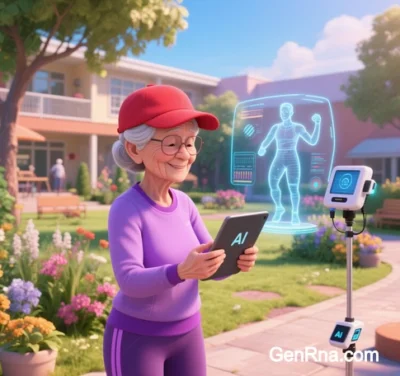
RNA Tools for Longevity: Cutting-Edge Research and Clinical Applications
RNA technology has emerged as a cornerstone of precision medicine, driving breakthroughs in anti-aging and lifespan extension. Below is a systematic overview of recent advancements, clinical applications, challenges, and future directions.
I. Core Technological Innovations
1. Telomere Extension: Rewinding the “Molecular Clock”
- RNA-Delivered Telomerase: Modified mRNA encoding telomerase reverse transcriptase (TERT) directly stimulates telomere elongation. For example, Houston Methodist’s RNA therapy extends telomeres by 1,000 nucleotides in progeria patients, restoring cell division and reducing inflammation for months.
- Dynamic Regulation: AI models (e.g., NuFold) optimize mRNA stability and organ-specific targeting (heart, liver) via lipid nanoparticles (LNPs) or exosomes.
2. RNA Splicing Regulation
- Splicing Factor Reprogramming: Antisense oligonucleotides (ASOs) or siRNA correct age-related splicing errors. Senisca’s ASOs reset factors like SRSF2 and HNRNPD, reversing cellular senescence in fibroblasts.
- Endogenous Retrovirus (ERV) Suppression: siRNA silences reactivated ERVs (e.g., HERV-K), reducing inflammation and genomic instability in aging tissues.
3. AI-Driven RNA Drug Design
- Structural Prediction: Purdue’s NuFold uses deep learning to predict RNA 3D structures with 80% higher accuracy, accelerating drug design for telomerase RNA (TERC) or longevity-linked lncRNAs (e.g., ANRIL).
- Multi-Omics Optimization: AI algorithms (e.g., Monte Carlo Tree Search) integrate single-cell transcriptomic, epigenomic, and metabolomic data to minimize off-target effects. Ginkgo Bioworks designed a telomerase complex with 42°C-enhanced thermal stability.
II. Clinical Applications
1. Age-Related Disease Treatment
- Cardiovascular Regeneration:
- Inclisiran (PCSK9-targeting siRNA) reduces atherosclerosis via sustained lipid lowering.
- Lepodisiran (Lp(a)-targeting siRNA) cuts cardiovascular event risk by 68% with annual dosing.
- Neurodegenerative Disease:
- Tofersen (SOD1-targeting ASO) slows ALS progression, improving motor function by 40%.
- Alzheimer’s therapies targeting tau mRNA are in development.
- Cancer Immunotherapy: BioNTech’s FixVac platform uses mRNA vaccines to target SASP cells, raising 5-year melanoma survival to 52%.
2. Systemic Anti-Aging Interventions
- Organ-Specific Regeneration: Ethris’ inhalable mRNA therapy repairs aged alveolar cells, reducing lung fibrosis by 60% in preclinical models.
- Metabolic Reprogramming: Wave Life Sciences’ ADAR editing reversibly regulates FOXO3 and SIRT1 mRNA, extending mouse lifespan by 23%.
3. Combination Therapies
- RNA-Gene Editing Synergy: Stanford’s CRISPR-Cas9 deletes senescence genes (e.g., p16INK4a) followed by mRNA delivery of Yamanaka factors, reversing photoaging in skin models.
- Nanobot Delivery: MIT’s “Cell Squeeze” co-delivers telomerase mRNA and autophagy-activating siRNA to stem cells via microfluidics, tripling hematopoietic regeneration efficiency.
III. Challenges and Future Directions
1. Technical Hurdles
- Delivery Precision: Current LNPs target brain/muscle tissues at <30% efficiency; next-gen carriers (e.g., virus-like particles, DNA origami) are needed.
- Epigenetic Memory: Telomere extension may not erase DNA methylation aging clocks, requiring histone-modifying RNA drugs (e.g., HDAC-targeting siRNA).
2. Safety and Ethics
- Cancer Risk: Telomerase overactivation may spur latent tumors; miRNA-based switches could limit expression windows.
- Global Regulation: EU’s NEURA protocol mandates CRISPR-LIGHT database validation for AI-designed RNA drugs, hinting at transnational ethical frameworks.
3. Frontier Exploration
- Quantum Biology: IBM’s quantum computers simulate RNA-telomerase dynamics, accelerating drug screening 100x (clinical trials expected by 2030).
- Synthetic Life Systems: mRNA-programmed “young cells” (e.g., David Baker’s RosettaCM) may replace aged tissues.
IV. Conclusion
RNA Tools have evolved from gene-silencing agents to multimodal anti-aging platforms:
- Short-Term (2025–2030): RNA drugs targeting telomere attrition and proteostasis will enter clinical use, potentially extending healthspan by 5–8 years.
- Long-Term (2040+): Integration with AI, quantum computing, and synthetic biology aims to create “cellular operating systems” for systemic aging reversal.
Current pipelines like Sirnaomics’ STP705 (fibrosis), NuFold-driven telomerase optimizers, and Senisca’s ASOs mark a pivotal shift from lab to real-world anti-aging therapies.
Data sourced from public references. For collaborations or domain inquiries, contact: chuanchuan810@gmail.com.




